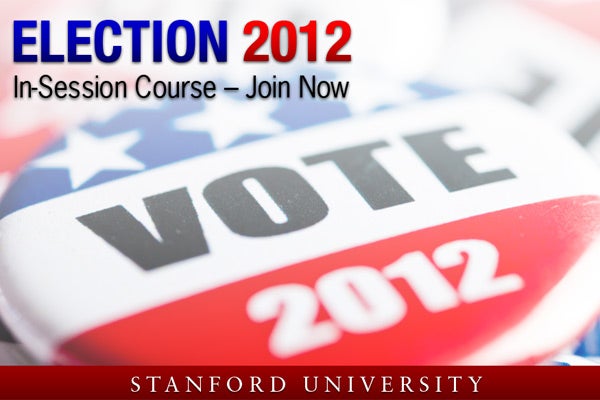|
October 11, 2012
Stanford studies up for Nov. 6 election
A standing-room-only course, available for online viewing, explores U.S. politics to provide a context both wide and deep for the presidential race. 
Some 14,000 people worldwide have enrolled in the 'Election 2012' online course at Stanford. (Photo: Courtesy of Stanford University)
Voter apathy surely is a serious problem, but not at Stanford, judging from the weekly turnout for an unusual course called Election 2012.
As Election Day approaches, thousands of Stanford students and members of the local community and beyond are keeping track of the issues. Stanford undergraduate students are taking the course as PoliSci 51K, Continuing Studies students are taking Pol 51, and engaged learners from around the world are taking advantage of the course free of charge on Stanford on iTunesU. Altogether, some 14,000 people have enrolled.
On Oct. 9 at Cemex Auditorium in the Knight Management Center, the 200-strong Continuing Studies contingent began showing up an hour early. Staff at the doors checked people's names to make sure they really were enrolled. The undergraduates, all 400 of them, arrived en masse 10 minutes before class started. The auditorium seats about 600.
It was a star billing that night: The presenters were Stanford Professor Emeritus Kenneth Arrow, who won the Nobel Memorial Prize in economic sciences in 1972, and fellow economics Professor John Taylor. The two of them would sort out the impact of the economy on the presidential race, along with related issues raised by the course's organizers, who share the stage with the guests in a quasi-panel arrangement.
Gavin Newsom, John Hennessy, others to speak
The 1-unit course is organized by David Kennedy, professor emeritus of history and faculty director of the Bill Lane Center for the American West; Rob Reich, associate professor of political science; and Jim Steyer, lecturer in comparative studies in race and ethnicity and founding CEO of Common Sense Media, a nonpartisan organization dedicated to improving the media for children and families.
The course began Sept. 25. Topics of discussion include campaign strategy, the history of the presidency, campaign finance and the Supreme Court. Special sessions will be held to view the presidential candidates' debates. Stanford President John Hennessy will speak on Oct. 30.
Two classes will take place after the election. On Thursday, Nov. 8, Steve Schmidt, campaign manager for Republican presidential candidate John McCain in 2008, will be the guest speaker. California Lieutenant Gov. Gavin Newsom will speak on Tuesday, Nov. 13.
The first two sessions were an exercise in contrasts. The course opened with three campaign experts analyzing the makings of the sausage. The panel included Democratic campaign strategist Chris Lehane, Republican campaign strategist Mark McKinnon and Stanford political science Professor Gary Segura.
They talked strategy, getting out of tight spots, why Hispanics and robo-calls don't mix, calculating Electoral College numbers (which states does Romney have to win if he doesn't get Ohio and Florida?) and the corrupting influence of money. All panelists deplored the U.S. Supreme Court's 2010 ruling in Citizens United v. Federal Election Commission, which opened the way for essentially unlimited campaign contributions by individuals and entities.
At the second class meeting, on Oct. 2, Kennedy took a big step back and talked about the institution of the U.S. presidency since the late 18th century. During the earlier era, he said, Congress played the leading role. It was only in the 20th century that the presidency assumed the aura it has today. Since the drafting of the Constitution, the American people have had a conflictive relationship with government in general and the presidency in particular, he said, as the public is suspicious and fearful of power yet also demands strong leadership.
Making their vote count
Reich ended the Oct. 2 session by returning to a point raised the previous week, when participants lamented that, because of the oddity of the Electoral College and new campaign finance rules, California has become little more than an ATM for candidates. Reich told any out-of-state students who might be in the crowded auditorium that if they want their vote to count, they might consider voting in their hometown if it's in a swing state.
The next session, on Oct. 16, will begin with a viewing session of the town hall–style debate between Democratic President Barack Obama and Republican presidential candidate Mitt Romney, followed by a panel discussion about the Supreme Court, featuring Stanford constitutional law Professor Pamela Karlan and California Supreme Court Justice Goodwin Liu.
Students and others wishing to follow the course can watch the Tuesday lectures as they become available on following Fridays on Stanford on iTunesU. Some of the lectures also will be on YouTube. Questions and announcements are being posted at Piazza.com.
-30-
|